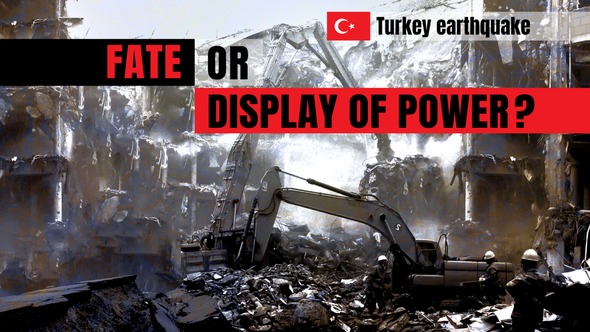Environment (English)
Turkey earthquake – Natural disaster or display of military power?
12.03.2023
Subtitle "Afrikaans" was produced by machine.Subtitle "አማርኛ" was produced by machine.Subtitle "العربية " was produced by machine.Subtitle "Ārāmāyâ" was produced by machine.Subtitle "azərbaycan dili " was produced by machine.Subtitle "беларуская мова " was produced by machine.Подзаглавието "България" е създадено от машина.সাবটাইটেল "বাংলা " মেশিন দ্বারা তৈরি করা হয়েছিল।Subtitle "བོད་ཡིག" was produced by machine.Subtitle "босански" was produced by machine.Subtitle "català" was produced by machine.Subtitle "Cebuano" was produced by machine.Subtitle "ગુજરાતી" was produced by machine.Subtitle "corsu" was produced by machine.Podtitul "Čeština" byl vytvořen automaticky.Subtitle "Cymraeg" was produced by machine.Subtitle "Dansk" was produced by machine.Untertitel "Deutsch" wurde maschinell erzeugt.Subtitle "Untertitel" was produced by machine.Ο υπότιτλος "Ελληνικά" δημιουργήθηκε αυτόματα.Subtitle "English" was produced by machine.Subtitle "Esperanto" was produced by machine.El subtítulo "Español" se generó automáticamente.Subtitle "Eesti" was produced by machine.Subtitle "euskara" was produced by machine.Subtitle "فارسی" was produced by machine.Subtitle "Suomi" was produced by machine.Le sous-titrage "Français" a été généré automatiquement.Subtitle "Frysk" was produced by machine.Subtitle "Gaeilge" was produced by machine.Subtitle "Gàidhlig" was produced by machine.Subtitle "Galego" was produced by machine.Subtitle "Schwizerdütsch" was produced by machine.Subtitle "هَوُسَ" was produced by machine.Subtitle "Ōlelo Hawaiʻi" was produced by machine.Subtitle "עברית" was produced by machine.Subtitle "हिन्दी" was produced by machine.Subtitle "Mẹo" was produced by machine.Podnaslov "Hrvatski" generiran je automatski.Subtitle "Kreyòl ayisyen " was produced by machine.Subtitle "Magyar" was produced by machine.Subtitle "Հայերեն" was produced by machine.Subtitle "Bahasa Indonesia " was produced by machine.Subtitle "Asụsụ Igbo " was produced by machine.Textun"Íslenska" var framkvæmt vélrænt.Sottotitoli "Italiano" sono stati generati con l'intelligenza artificiale.字幕は"日本語" 自動的に生成されました。Subtitle "Basa Jawa" was produced by machine.Subtitle "ქართული" was produced by machine.Subtitle "қазақ тілі " was produced by machine.Subtitle "ភាសាខ្មែរ" was produced by machine.Subtitle "ಕನ್ನಡ" was produced by machine.Subtitle "한국어" was produced by machine.Subtitle "कोंकणी語" was produced by machine.Subtitle "کوردی" was produced by machine.Subtitle "Кыргызча" was produced by machine.Subtitle " lingua latina" was produced by machine.Subtitle "Lëtzebuergesch" was produced by machine.Subtitle "Lingala" was produced by machine.Subtitle "ພາສາ" was produced by machine.Antraštė "Lietuvių" buvo sukurta mašina.Subtitle "Latviešu" was produced by machine.Subtitle "fiteny malagasy" was produced by machine.Subtitle "te reo Māori" was produced by machine.Subtitle "македонски јазик" was produced by machine.Subtitle "malayāḷaṁ" was produced by machine.Subtitle "Монгол хэл" was produced by machine.Subtitle "मराठी" was produced by machine.Subtitle "Bahasa Malaysia" was produced by machine.Subtitle "Malti" was produced by machine.Subtitle "မြန်မာစာ " was produced by machine.Subtitle "नेपाली" was produced by machine.Ondertitels "Nederlands" machinaal geproduceerd.Subtitle "Norsk" was produced by machine.Subtitle "chiCheŵa" was produced by machine.Subtitle "ਪੰਜਾਬੀ" was produced by machine.Podtytuł "Polska" został utworzony przez maszynę.Subtitle "پښتو" was produced by machine.Legenda "Português" foi gerada automaticamente.Subtitle "Română" was produced by machine.Subtitle "Язык жестов (Русский)" was produced by machine.Субтитры "Pусский" были созданы машиной.Subtitle "Kinyarwanda" was produced by machine.Subtitle "सिन्धी" was produced by machine.Subtitle "Deutschschweizer Gebärdensprache" was produced by machine.Subtitle "සිංහල" was produced by machine.Subtitle "Slovensky" was produced by machine.Subtitle "Slovenski" was produced by machine.Subtitle "gagana fa'a Samoa" was produced by machine.Subtitle "chiShona" was produced by machine.Subtitle "Soomaaliga" was produced by machine.Titra "Shqip" u krijua automatikisht.Превод "србски" је урађен машински.Subtitle "Sesotho" was produced by machine.Subtitle "Basa Sunda" was produced by machine.Undertext "Svenska" är maskinell skapad.Subtitle "Kiswahili" was produced by machine.Subtitle "தமிழ்" was produced by machine.Subtitle "తెలుగు" was produced by machine.Subtitle "Тоҷикй" was produced by machine.Subtitle "ภาษาไทย" was produced by machine.ንኡስ ኣርእስቲ "ትግርኛ" ብማሽን እዩ ተፈሪዩ።Subtitle "Türkmençe" was produced by machine.Subtitle "Tagalog" ay nabuo sa pamamagitan ng makina.Altyazı "Türkçe" otomatik olarak oluşturuldu.Subtitle "татар теле" was produced by machine.Subtitle "Українська " was produced by machine.ذیلی عنوان "اردو" مشین کے ذریعہ تیار کیا گیا تھا۔Subtitle "Oʻzbek" was produced by machine.Phụ đề được tạo bởi máy.Subtitle "Serbšćina" was produced by machine.Subtitle "isiXhosa" was produced by machine.Subtitle "ייִדיש" was produced by machine.Subtitle "Yorùbá" was produced by machine.Subtitle "中文" was produced by machine.Subtitle "isiZulu" was produced by machine.
kla.TV accepts no liability for defective translation.kla.TV accepts no liability for defective translation.kla.TV accepts no liability for defective translation.kla.TV accepts no liability for defective translation.kla.TV accepts no liability for defective translation.kla.TV accepts no liability for defective translation.kla.TV не носи отговорност за некачествен превод.অপর্যাপ্ত অনুবাদের জন্য kla.TV কোন দায় বহন করে না।kla.TV accepts no liability for defective translation.kla.TV accepts no liability for defective translation.kla.TV accepts no liability for defective translation.kla.TV accepts no liability for defective translation.kla.TV accepts no liability for defective translation.kla.TV accepts no liability for defective translation.kla.TV nenese žádnou odpovědnost za chybné překlady.kla.TV accepts no liability for defective translation.kla.TV accepts no liability for defective translation.kla.TV übernimmt keine Haftung für mangelhafte Übersetzung.kla.TV accepts no liability for inadequate translationΗ kla.TV δεν φέρει καμία ευθύνη για ανεπαρκή μετάφραση.kla.TV accepts no liability for defective translation.kla.TV accepts no liability for defective translation.kla.TV no se hace responsable de traducciones incorrectas.kla.TV accepts no liability for defective translation.kla.TV accepts no liability for defective translation.kla.TV accepts no liability for defective translation.kla.TV accepts no liability for defective translation.kla.TV n'assume aucune responsabilité en cas de mauvaise traduction.kla.TV accepts no liability for defective translation.kla.TV accepts no liability for defective translation.kla.TV accepts no liability for defective translation.kla.TV accepts no liability for defective translation.kla.TV accepts no liability for defective translation.kla.TV accepts no liability for defective translation.kla.TV accepts no liability for defective translation.kla.TV accepts no liability for defective translation.kla.TV accepts no liability for defective translation.kla.TV accepts no liability for defective translation.kla.TV ne preuzima nikakvu odgovornost za neadekvatne prijevode.kla.TV accepts no liability for defective translation.kla.TV nem vállal felelősséget a hibás fordításértkla.TV accepts no liability for defective translation.kla.TV accepts no liability for defective translation.kla.TV accepts no liability for defective translation.kla.TV tekur enga ábyrgð á áræðanleika þýðingarinnarKla.TV non si assume alcuna responsabilità per traduzioni lacunose e/o errate.Kla.TV は、不適切な翻訳に対して一切の責任を負いません。kla.TV accepts no liability for defective translation.kla.TV accepts no liability for defective translation.kla.TV accepts no liability for defective translation.kla.TV accepts no liability for defective translation.kla.TV accepts no liability for defective translation.kla.TV accepts no liability for defective translation.kla.TV accepts no liability for defective translation.kla.TV accepts no liability for defective translation.kla.TV accepts no liability for defective translation.kla.TV accepts no liability for defective translation.kla.TV accepts no liability for defective translation.kla.TV accepts no liability for defective translation.kla.TV accepts no liability for defective translation.kla.TV neprisiima jokios atsakomybės už netinkamą vertimą.kla.TV accepts no liability for defective translation.kla.TV accepts no liability for defective translation.kla.TV accepts no liability for defective translation.kla.TV accepts no liability for defective translation.kla.TV accepts no liability for defective translation.kla.TV accepts no liability for defective translation.kla.TV accepts no liability for defective translation.kla.TV accepts no liability for defective translation.kla.TV accepts no liability for defective translation.kla.TV accepts no liability for defective translation.kla.TV accepts no liability for defective translation.kla.TV aanvaardt geen aansprakelijkheid voor foutieve vertalingen.kla.TV accepts no liability for defective translation.kla.TV accepts no liability for defective translation.kla.TV accepts no liability for defective translation.kla.TV nie ponosi odpowiedzialności za wadliwe tłumaczenie.kla.TV accepts no liability for defective translation.kla.TV não se responsabiliza por traduções defeituosas.kla.TV accepts no liability for defective translation.kla.TV accepts no liability for defective translation.kla.TV не несет ответственности за некачественный перевод.kla.TV accepts no liability for defective translation.kla.TV accepts no liability for defective translation.kla.TV accepts no liability for defective translation.kla.TV accepts no liability for defective translation.kla.TV accepts no liability for defective translation.kla.TV accepts no liability for defective translation.kla.TV accepts no liability for defective translation.kla.TV accepts no liability for defective translation.kla.TV accepts no liability for defective translation.kla.TV nuk mban asnjë përgjegjësi për përkthime joadekuate.kla.TV не преузима никакву одговорност за неадекватне преводе..kla.TV accepts no liability for defective translation.kla.TV accepts no liability for defective translation.Kla.TV tar inget ansvar för felaktiga översättningar.kla.TV accepts no liability for defective translation.kla.TV accepts no liability for defective translation.kla.TV accepts no liability for defective translation.kla.TV accepts no liability for defective translation.kla.TV accepts no liability for defective translation.kla.TV ንዝኾነ ጉድለት ትርጉም ዝኾነ ይኹን ሓላፍነት ኣይቅበልን እዩ።kla.TV accepts no liability for defective translation.kla. Walang pananagutan ang TV sa mga depektibong pagsasalin.kla.TV hatalı çeviriler için hiçbir sorumluluk kabul etmez.kla.TV accepts no liability for defective translation.kla.TV accepts no liability for defective translation.kla.TV عیب دار ترجمہ کے لیے کوئی ذمہ داری قبول نہیں کرتا ہے۔kla.TV accepts no liability for defective translation.Kla. TV không chịu trách nhiệm về bản dịch không đầy đủ.kla.TV accepts no liability for defective translation.kla.TV accepts no liability for defective translation.kla.TV accepts no liability for defective translation.kla.TV accepts no liability for defective translation.kla.TV accepts no liability for defective translation.kla.TV accepts no liability for defective translation.
Turkey earthquake – Natural disaster or display of military power?
12.03.2023
www.kla.tv/25401
The disastrous earthquake of February 6, 2023 in the Southeast of Turkey and North Syria has reached shocking levels of devastation, while the human death toll continues to skyrocket. Scientists around the globe are more than shocked by this extreme drifting apart by several meters of the earth's crusts during this quake.
[continue reading]
Turkey earthquake – Natural disaster or display of military power?
Download broadcast and attachments in the wanted quality:
Hashtags: #WeatherManipulation-en
Useage rights:
Standard-Kla.TV-Licence

 Deutsch-ID setzten
Deutsch-ID setzten



12.03.2023 | www.kla.tv/25401
Unprecedented images of completely collapsing or completely toppled apartment blocks give the observer only a glimpse of the extraordinary force of this earthquake. But what many people helplessly accept as an inevitable stroke of fate or as “God-given”, raises questions that need to be clarified on closer examination. In the last few days, there have been increasing reports of witnesses observing anomalies in the Turkish sky just prior to the earthquake, such as unusual spiral cloud formations, as well as persistent electrostatic discharges and lightning in the upper atmosphere. Could these be possible indications that radiation weapons are used, which can also cause artificially generated earthquakes by using the electromagnetic properties of our ionosphere? That this is not a mere conspiracy theory, but an obvious fact of practically applicable military technology should be obvious at least since a convention of the United Nations in 1976 (!). Apparently, at the time of the so-called “Cold War” between the USA and the Soviet Union, a real arms race took place not only in conventional weapons, but also at the level of weather and earthquake weapons. Their existence and use are still largely kept secret today. Nevertheless, the UN came up with a so-called ENMOD convention, and certainly not without reason. It bans the military or any other hostile use of environment-altering technologies. Specifically mentioned are: Earthquakes, tidal waves, disturbance of the ecological balance of a region, changes in weather structures such as clouds, precipitation, various types of hurricanes and tornadoes, changes in climate structures, changes in ocean currents, changes in the state of the ozone layer, and changes in the state of the ionosphere. Since the 1970s at the latest, earthquakes have been increasing more frequently worldwide, especially those with hypocenters located in a relatively shallow depth of exactly 10 km – a particularly seismologically critical zone, since the water stored inside the earth in this area is very close to the boiling point, to gas evaporation. With just a little targeted additional energy to amplify the earth’s own resonant frequency, strong pressure waves can be generated inside the earth, which have particularly destructive effects in areas that are already at risk of earthquakes. Numerous countries around the world signed the UN convention, including the Soviet Union and the U.S. somewhat reluctantly in the 1980s. The U.S., however, signed the voluntary commitment with certain caveats, the contents of which are not publicly available to this day. However, this signing some 40 years ago does not guarantee that such devious weapon systems were actually not used afterwards. Rather, it must be assumed that military technology that is already known will continue to be researched and its possible uses further specified as long as there are no concrete charges of war crimes against humanity that are binding under international law. It has not been proven that the destructive quakes on the morning of February 6th, 2023 in the Turkish-Syrian border region have not been a natural disaster, but war crimes. However, it is striking that the quakes with the values of 7.7 and 7.6 on the Richter scale occurred one after the other, each at a depth of exactly 10 km, whereby the second quake was interestingly “adjusted” to 15 km afterwards. Moreover, no relevant foreshocks above the magnitude value of 4.0 were registered in the weeks before. Aftershocks, on the other hand, even stronger ones, occurred hundreds of times during the following days. These can also be additional growing evidence for the deliberate use of earthquake weapons. Direct proof, however, remains difficult, especially the direct attribution of precisely who is insidiously practicing the use of such weapons, which are prohibited under international law. However, there are other anomalies and questions about the quake in southern Turkey: For example, has Turkey under Erdogan become an increasingly unreliable ally from the perspective of the U.S.-led NATO? For example, Turks have not yet shown any willingness to cooperate with regard to Sweden’s NATO accession, which has caused relations with the United States to sink to a low point. Turkey’s increasing political and economic orientation toward Russia and China, on the other hand, has recently become more and more significant, not only with regard to the supply of Russian natural gas via the Black Sea pipeline TurkStream. Turkey has also increasingly become an important hub for Europe’s energy supply and is itself one of the largest consumers of Russian natural gas. Turkey is also of great importance as a transit country for the European and Asian oil trade. The consequences of the earthquake are currently massive for the emerging Turkish energy industry: For example, the operation of the important oil export terminal in Ceyhan, where, among other things, the pipelines from northern Iraq and Azerbaijan end, was suspended. These pipelines run right through the earthquake zone in south-east Turkey. But also on the level of international politics, Turkey acted ever more self-confident under Erdogan. Through Turkey’s initiative, a peace agreement was negotiated between Russia and Ukraine in Istanbul on March 29, 2022, which, however, was clearly rejected by the West and was ultimately thwarted. It was also Russia that provided Turkey with clear indications of a planned military coup against the Erdogan government in 2016, which was already at an early stage but remained unsuccessful. As unpredictable as the Turkish government may be acting from Western perspectives, Turkey is all the more a strategically important NATO partner. After all, the NATO Incirlik [Insörlik] air base is located right in the middle of the Turkish-Syrian border region and thus not only close to the epicenter of the mega-earthquake, but also directly on the border with the still unpacified Turkish-Syrian and Turkish-Kurdish war zones. In addition, Incirlik certainly remains an important airbase strategically located between the Black and Caspian Seas, which have largely been Russian territorial waters. And last but not least, a waterway of extreme economically and militarily importance is under Turkish control: the Bosphorus Strait, which leads through Istanbul via the Dardanelles directly from the Black Sea into the Mediterranean, and thus opens the way for Russia to the world’s oceans and, the other way around, the way for the U.S. Navy to Russia’s doorstep. If Erdogan does not prove as reliable and to be a compliant gatekeeper, he surely will, from the U.S. perspective, pose a serious “security risk”. A possible reason for the use of earthquake weapons as leverage and a “warning shot across the bow” of President Erdogan, who is already on shaky ground domestically? “Not at all,” one might say, since the loyal NATO partners from the U.S. were right on the scene quickly with a large army of helpers and rescuers just a few hours after the quake. But the U.S. aid mission will probably not be entirely altruistic, considering that the U.S. Navy’s aid missions in the recent past involved the (well-prepared) establishment of naval bases as well. This happened, for example, after the devastating earthquake in Haiti in 2010 and after the 2004 seaquake off Indonesia. The presence of the U.S. Navy there made it possible to control one of the world busiest sea lanes, the Strait of Malacca, very close to China’s doorstep. It therefore remains to be seen and closely observed which interests such terrible natural disasters serve, especially in geopolitical and military terms, and who they harm in the long run – apart from the damaged population. Should the use of internationally outlawed earthquake weapons be substantiated and proven by unmistakable evidence, this action must be punished as “geopolitical terrorism” for mass destruction and as a war crime in XXL format and from now on, brought under independent control.
from ham.
Report of the Committee on Foreign Affairs, Security and Defense Policy in the European Parliament from 1995 with explicit mention of the military research facility HAARP in Alaska/USA https://www.europarl.europa.eu/doceo/document/A-4-1999-0005_DE.pdf?redirect
Weather as a weapon (excerpt from the Terra-X program “Wild Planet – Part Three: Storms,” broadcast on ZDF on April 27, 2013) https://www.youtube.com/watch?v=ay31-KL87hc
Documentary by “Conrebbi” on the occasion of the Fukushima quake on March 11, 2011: https://www.youtube.com/watch?v=npzvWGZfdho
Resonant frequency of the earth, so-called “Schumann frequency”: https://lebensfeldstabilisator.de/innere-harmonie-resonanz-mit-den-positiven-kraeften/
https://odysee.com/@EvaHermanOffiziell:1/08.02.23_Wettermanipulation_Erdbeben:a
https://odysee.com/@MaxWende:f/LION-Media---Erdbeben-als-Waffe---Wurde-die-Tuerkei-angegriffen----09.02.2023:3
https://odysee.com/@moonjunky:e/Deprem-Korkunc-G%C3%B6r%C3%BCnt%C3%BCler-Erdbeben-T%C3%BCrkei-aktuelle-Videos-Earthquake-Turkey-2023-Videos:9
Sky observations just before the quake in Turkey: https://odysee.com/@ChristopherKennethBowser:6/People-saw-strange-light-in-sky-before-Turkey-Earthquake.--t:c
https://odysee.com/@Flogbags:2/SKIES-ABOVE-TURKEY-JUST-BEFORE-EARTHQUAKE:1
Lightning before the quake: https://odysee.com/@Lighthousenews:8/video_2023-02-07_18-41-35:c
GFZ German Research Centre for Geosciences earthquake info worldwide; earthquakes arranged chronologically, with magnitude values and coordinates of the epicenter https://geofon.gfz-potsdam.de/
Strikingly strong drifting apart of the continental plates: https://www.bbc.com/news/science-environment-64603521
Petroleum and energy supply by Turkey: https://www.chemietechnik.de/anlagenbau/tuerkei-und-russland-eroeffnen-gas-pipeline-durch-das-schwarze-meer.html
https://emweo.de/news/erdbeben-in-der-tuerkei-trifft-oelindustrie/
https://www.dena.de/fileadmin/dena/Dokumente/Pdf/3074_Laenderprofil_Tuerkei_REG.pdf
[page 16]